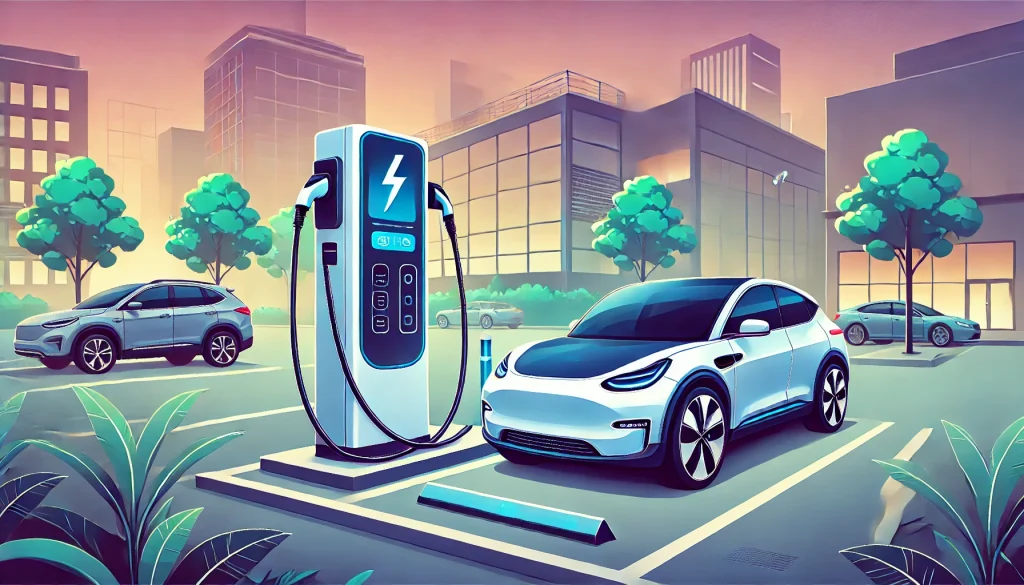Understanding Electric Vehicle Chargers in the US

DOWNLOAD NOW THE Understanding Electric Vehicle Chargers in the US PDF
What are the types of electric vehicle (EV) chargers in the US?
What are the most efficient ones?
What is the right one for you?
You will learn about the various types of chargers in the U.S.
What sets them apart, their conception, and what experts think about each of them.
A Brief History of Electric Vehicle Chargers in the US
Chargers have evolved since the early days of EVs.
The concept dates back to the late 19th century, with the first electric vehicles.
In the 1990s, General Motors EV1 introduced the modern charger as we know it.
The need for efficient charging solutions became more pressing with the EV1’s release.
The early chargers were cumbersome and slow.
But quick updates led to the development of better chargers.
More sophisticated, faster, and user-friendly.
Today, the US market offers a huge variety of chargers designed for different needs.
Today, the US market offers a variety of electric vehicle chargers designed to meet different needs and preferences.
Electric Vehicle Chargers in the US
Level 1 Chargers
Features
- Uses a standard 120-volt household outlet
- Charging speed: 2–5 miles of range per hour
Benefits
- Accessibility: Easily plugged into any standard outlet
- Cost-Effective: No extra installation costs
Level 1 chargers are the most basic type of electric vehicle chargers.
They use a standard 120-volt household outlet, which makes them accessible and easy to use.
Yet, their charging speed is slow, adding 2–5 miles of range per hour.
Designed for those who can leave their car charging overnight.
Level 1 chargers can be the most cost-effective and convenient option.
Level 2 Chargers
Features
- Uses a 240-volt outlet (like those used for electric dryers)
- Charging speed: 10–60 miles of range per hour
Benefits
- Faster Charging: Significantly quicker than Level 1 chargers
- Versatility: Suitable for both home and public charging stations
Level 2 chargers represent a significant step up in charging speed and efficiency.
They need a 240-volt outlet, like what you would use for an electric dryer,
But this means an extra 10–60 miles of range per hour.
Ideal for home use.
Many public charging stations across the US also use Level 2 chargers.
This is what makes them the most versatile option.
DC Fast Chargers
Features
- Uses direct current (DC) instead of alternating current (AC)
- Charging speed: 60-100 miles of range in 20 minutes
Benefits
- Rapid Charging: Ideal for quick top-ups during long trips
- Convenience: Available at many public charging stations
If you want speed, you must get to know the DC Fast Chargers.
The Level 1 and Level 2 chargers use alternating current (AC).
But the DC fast chargers use direct current (DC).
Delivering power directly to the car’s battery.
This allows them to charge an EV much faster.
Being able to charge 60–100 miles of range in mind-blowing 20 minutes.
All these benefits come with a downside.
Way more expensive to install and harder to get.
Most commonly found at public charging stations.
Tesla Superchargers
Features
- Exclusive to Tesla vehicles
- Charging speed: Up to 200 miles of range in 15 minutes
Benefits
- Ultra-Fast Charging: One of the fastest charging options available
- Extensive Network: Widely available at Tesla charging stations
If you want ultra-speed, you must get to know the Tesla Superchargers.
Tesla Superchargers are a type of DC Fast Charger.
Designed only for Tesla vehicles.
100 miles in 20 minutes is nothing compared to Tesla`s 200 miles in only 15 minutes!
Add this unbeatable charge speed to Tesla`s extensive network of chargers across the US.
You make car travel in EVs workable and convenient.
EV Chargers by Location
Workplace Chargers
Features
- Typically, Level 2 chargers
- Installed at business locations
Benefits
- Convenience: Charge while you work
- Encourages EV Adoption: Employers supporting green transportation
Workplace chargers are usually Level 2 chargers installed at business locations.
They allow employees to charge their vehicles while they work.
This promotes convenience and encourages the adoption of electric cars.
The availability of workplace chargers is increasing across the US.
Public Charging Stations
Features
- A mix of Level 2 and DC Fast Chargers
- Found in urban areas, shopping centers, and highways
Benefits
- Accessibility: Widely available for public use
- Supports Long-Distance Travel: Essential for EV road trips
Public charging stations are essential for supporting the widespread use of electric vehicles.
These stations often feature Level 2 chargers.
Sometimes even DC fast chargers.
Strategically located in urban areas, shopping centers, and along highways.
Core for EV owners who don`t own home chargers.
Insights and Statistics
In 2020, the International Energy Agency (IEA) reported more than 1 million EVs worldwide.
The Department of Energy reports more than 100,000 public charging stations.
Elon Musk highlights the need for a robust charging infrastructure to support EVs.
“The future of transportation is electric, and a comprehensive charging network is essential for mass adoption.” Elon Musk is Tesla`s CEO.
Summarizing
The US recently started to adopt EV usage.
This is a campaign that has long roads to travel and many upgrades and changes.
Staying informed about your charging options is key for every EV owner.
I hope you have a deep grasp of your options and what each of them represents.
For sure, Tesla`s Supercharger seems like a blink into the future, don`t you think?




